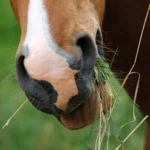Where Does Sweet Itch Actually Come From?
Much has been written about sweet itch, and most affected horse owners believe they know
the answer: “There’s nothing you can do; it’s just an allergy to insect bites.” Nowadays, it’s even
possible to test your horse for the so-called “sweet itch gene.”
What’s Really Behind It?
Initially, sweet itch was labeled as the “Icelandic horse eczema”, but today it affects horses of all breeds and age groups. Particularly affected are sturdy and baroque-type horses, including Icelandic horses, Haflingers, Freibergers, PREs, and Friesians. However, Arabians and warmbloods are not spared either.
Is the Allergy to Insect Bites True?
Yes, horses are indeed allergic or hypersensitive to insect bites. This is clearly evident, as the itching ceases when horses wear a sweet itch rug that prevents insects from reaching their skin. The bigger question, however, is: why does one horse develop an allergy while another does not?
Metabolism and Sweet Itch
To better understand sweet itch, let’s take a closer look at the horse’s metabolism. The elimination
of waste products in horses – as in all mammals – occurs through various excretory organs:
Digestive System
The gut system primarily excretes indigestible waste, along with waste products transported from the liver via bile.
Kidneys
The kidneys play a critical role in excreting all water-soluble substances that the liver processes during detoxification. However, capacity is limited, as the kidneys also manage other vital tasks, including maintaining a stable acid-base balance, regulating mineral and water levels, and controlling blood pressure.
Skin as an Auxiliary Kidney in Emergencies
When the kidneys are overwhelmed, the body can redirect waste excretion to the skin as an emergency measure. Studies have shown that sweat glands function similarly to renal tubules, utilizing comparable mechanisms to expel waste through sweat. The sebaceous glands can be utilized for the excretion of fat-soluble waste products.

Reaction of the Skin
Aggressive waste products deposited on the skin’s surface can lead to mild irritations since the skin is not designed to handle these substances. These irritations trigger inflammatory responses from the immune system, which concentrates its efforts in the skin to combat bacteria, fungi, and other pathogens entering through the damaged areas. When the saliva of blood-sucking insects is introduced, the immune system overreacts, resulting in an allergic response. Scratching causes small skin injuries, allowing further pathogens to invade and placing additional strain on the immune system. Meanwhile, the continuous excretion of waste through the skin perpetuates irritation.
Emergency Becomes a Chronic Condition
In some horses, the metabolism becomes so overloaded that the skin effectively becomes the primary excretory organ. These horses scratch themselves incessantly, even during winter. Often, they suffer from a chronically inflamed intestine, where mucous membrane cells release excessive amounts of histamine, increasing skin sensitivity to allergens. In such cases, the acid-base balance in the connective tissue is disrupted, the liver struggles to process the accumulating waste, and the body can barely sustain essential metabolic functions. What may start as harmless tail rubbing can escalate into severe conditions.
Difficult Diagnosis
One major challenge with sweet itch is that its underlying causes cannot be detected through a blood test. Indicators of renal insufficiency, such as reduced kidney performance, only become apparent when about 70% of the kidneys have already been destroyed – by which time it is far too late. Connective tissue hyperacidity also goes unnoticed because the blood’s pH level is tightly regulated and remains constant.
Increased Allergy Signs Become Visible

The signs of an allergic reaction are only evident because the overloaded immune system’s response becomes visible on the skin. However, the allergy is not the root cause but rather a symptom – a consequence of a disrupted metabolism. Many horses with sweet itch also develop additional symptoms or conditions, including chronic cough, fecal water, colic, poor hoof quality, delayed moulting, and even EMS or Cushing’s. Affected horses are often lethargic and show little energy. Even measures like sweet itch rugs, creams, sprays, or relocating the horse to coastal or high-altitude areas during summer provide only temporary relief. They do not address the root cause, leaving horse owners feeling just as desperate as their horses.
Intestine
What to Do About It?
The first and most important step is to use a sweet itch rug or blanket to reduce stress. This is often necessary for one or two summers at the beginning of sweet itch therapy, as it can take that long to restore the metabolism to its natural balance.
Insect repellent
For mild cases of sweet itch, applying an insect repellent is often sufficient. Spraying with Tyrolean stone oil (www.steinoel.at) has proven to be effective and is one of the few remaining agents that works against blood-sucking insects in Europe. Use whatever works best in your region.
Soothe the Skin
The skin can be soothed externally with ointments such as calendula cream, which help keep it soft and moisturised. Avoid ointments on paraffin oil bases, as these create a greasy film that prevents the skin from moisturizing itself and can lead to further dryness. Instead, support the skin from the inside by feeding seeds rich in high-quality essential fatty acids like OKAPI Wild Seeds.
Stabilize Skin Microbiome
Spraying the skin several times daily with diluted Effective Microorganisms (EM-1) can help stabilize the skin microbiome and promote faster recovery. This also combats harmful pathogens on the skin’s surface before the immune system becomes involved. The inside of the sweet itch rug can also be sprayed with EM-1 for additional support.
Optimize Feeding
Most horses with sweet itch suffer from a disturbed intestinal environment as the root cause for their detoxification issues. Therefore, therapy should always begin with optimizing feeding and restoring the intestinal balance. Focus on reducing sugar and acids in the diet and eliminating concentrate feeds for at least six months. After this period, crushed barley or oats may be reintroduced, depending on the horse’s con- dition. Haylage must be removed from the diet, even during winter. If haylage has been fed, a colon restoration is necessary, along with the addition of OKAPI Prodic. Replace haylage with late-harvested, stalky hay. If the hay is too rich, it can be soaked in water for 30 minutes to reduce its sugar content.

Colon Restoration
After changing the feed, it’s essential to carry out a colon restoration protocol. For detailed information, refer to the brochure ‘Colon Restoration’.
Test for Kryptopyrroluria (KPU)
Almost all horses with sweet itch have an underlying liver disorder and should be tested for Kryptopyrroluria (KPU). More information can be found in the brochure on KPU. If the horse tests positive for KPU, this condition must be addressed first before beginning any other therapy.
Support Kidney and Liver
Alongside liver support, such as with OKAPI HeparKPU forte, the kidneys also require assistance. Products like OKAPI Detox Herbs can help provide this support.
Detoxify and Strengthen the Immune System
OKAPI Spirulina can be fed for 6–8 weeks to support detoxification. It contains substances that bind toxins, making them easier to eliminate. To boost the immune system, use OKAPI Immuno Herbs in a cycle of one week with herbs and one week without for 8–12 weeks. OKAPI Zinc Plus, combined with OKAPI Sulphur Plus (MSM), further supports liver detoxification, immune function, and skin regeneration.

Long-Term Measures
To prevent a recurrence of sweet itch, it’s crucial to maintain the new feeding regimen over the long term. Avoid haylage, carrots, beet pulp, chaff, and large quantities of concentrate feed. Ensure the horse has an ample supply of hay, summer pasture access, and an appropriate mineral intake, such as seaweed alternating with OKAPI minerals. Seaweed provides essential trace and microelements vital for the horse’s metabolism. OKAPI Seaweed is particularly beneficial for sturdy breeds like native ponies, Icelandic horses, Haflingers, and draft horses with sweet itch. These breeds often struggle with hay and grass due to an unfavorable sugar-to-protein-to-mineral ratio. As a long-term alternative to concentrate feed, we recommend OKAPI Four Seasons Feed. This pure herbal blend contains seasonal herbs tailored to support the horse’s needs and is ideal for mixing in unpalatable supplements.
Help with Moulting
Horses affected by sweet itch benefit from OKAPI Detox Herbs, OKAPI Wild Seeds, and OKAPI Spirulina during the moulting season. These supplements support their metabolism and relieve stress on the kidneys during this demanding period.
- Assessing the correct body condition in horses - 21. June 2025
- Sugar levels in grass – when do they become a problem? - 19. June 2025
- Choosing the Right Fly Sheet: The Ultimate Guide for Horse Owners - 13. June 2025










